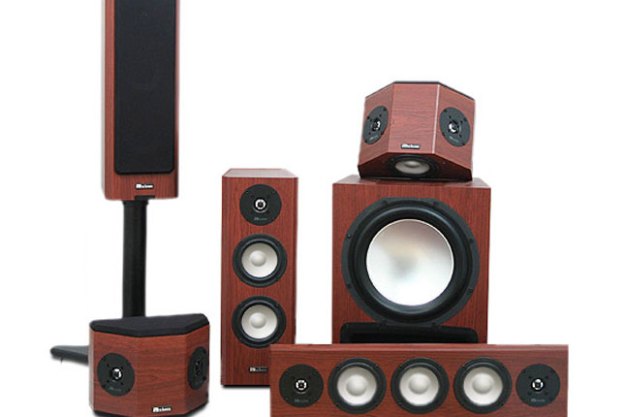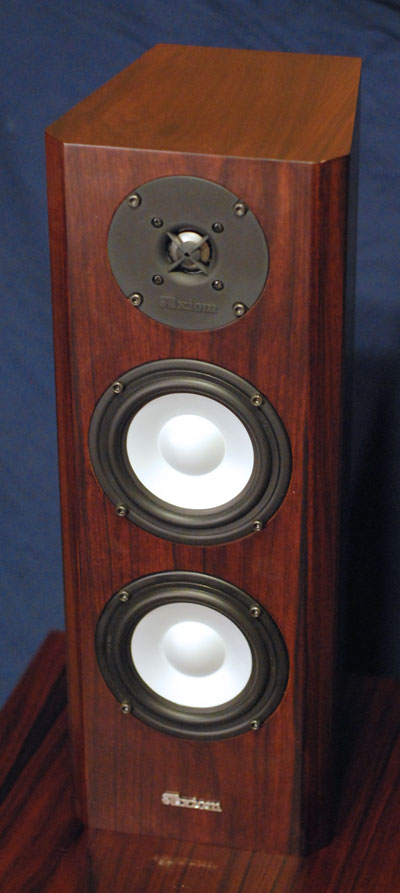
“Axiom’s Epic Grand Master 500 speaker system lives up the company’s outstanding reputation with uncompromised home theater performance.”
- Excellent sound and build quality
- Space conscious cabinet design
- Rock solid subwoofer performance
- Reasonably priced
- Bulky subwoofer
- Premium finish options are expensive
- High frequencies may be aggressive for some listeners
Introduction
If you’ve done any internet research on high-end loudspeakers, then you are no doubt already familiar with Axiom audio. For those not yet in the know, Axiom Audio is an Ontario, Canada based speaker manufacturer that just happens to be celebrating its 30-year anniversary. Axiom began in a garage one day when chief designer Ian Colquhoun crafted his first pair of speakers, then grew over time as a new-found company developed one award winning product after another. Roughly ten years ago, Axiom launched its website, began selling products directly to customers all over the world and changed the game for speaker makers everywhere. One of the pioneers of the Internet-direct selling model, Axiom bypasses costly distribution and sales channels and is able to offer a high-quality product at prices that defy convention.

Out of the Box
Since Axiom is an internet-direct speaker maker, they ship all of their products from their manufacturing facility in Ontario, Canada. For that reason, product packaging is extremely important. No one wants to spend considerable bucks on a speaker system, wait a week or so for it to arrive then find out that their gear has been damaged in transit. To avoid this issue, Axiom has done a top-notch job of isolating and padding their speaker boxes to ensure safe transit.
Beyond the foam padding we found each speaker cinched up in black cloth sacks. As we disrobed each speaker, we noted that our review system came with a real Rosewood veneer dressed with a satin finish. By default, Axiom’s speakers are priced with either Boston Cherry or Black Oak vinyl finishes but, for an additional fee, Axiom offers a myriad of very attractive finishing options for their entire line of speakers. You may choose from 15 custom vinyl finishes or opt for one of six different real wood finishes with your choice of satin, semi-gloss or piano gloss. There is also an option for a solid, high gloss piano black finish. Custom finished speakers are made to order, so delivery will be extended out anywhere from 10-20 days beyond the normal shipping time frame.
The quality of the Rosewood finish was excellent. Be aware, however, that the real wood finish options come with a bit of an upgrade fee. For this system, real wood finishes add $755.00 to the asking price; $1211.00 for the Rosewood version that we received.
Features and Design
All of the speakers in the Epic 500 system (save the subwoofer, of course) use the same 5.25” midrange driver and 1” titanium dome tweeter, albeit in various configurations.
The M22 bookshelf speaker combines two of the 5.25” drivers with one tweeter in a tall, slim, rear-ported cabinet. It is rated to play down to 60hz, and measures 19.8″ x 7.3″ x 8″ and 16 lbs.
The VP150 center channel is comprised of three, center mounted 5.25” drivers with two tweeters on the far side of its sealed cabinet. It is rated to perform down to 85hz and measures in at 7.5″ x 27.5 ” x 7.5 and 21.8 lbs.

The QS8 surrounds are cleverly designed in a trapezoid shaped cabinet with one of two 5.25” drivers on the top and the other on the bottom. Each tweeter is positioned on opposing faces of the trapezoid, thus aiming sound left, right, up and down. The speaker is rated to play flat down to 95hz and measures in at measures 8.25″ x 11″ x 6” and 13.5 lbs. Each QS8 comes packed with a wall mount kit that positions the speaker flush against the wall. Given the nature of the design, the speaker really should be placed on the wall. To stand mount it, one would need to come up with a clever stand solution, since the driver at the bottom needs to be able to play into the room, not into the base of a stand.

The EP500 DSP subwoofer is built the old fashioned way: with a big driver, big cabinet and big amp. The 19.5″ x 15″ x 19.5”cabinet is vented on the front and houses a single, 12” woofer and a 500 watt RMS DSP controlled amplifier which add up to a combined weight of 72.6 lbs.
Performance
We tested the Axiom Epic Grandmaster 500 speaker system in a moderately sized, acoustically treated room. Associated test equipment included a Marantz SR6005 A/V receiver, LG BD 370 Blu-Ray disc player, Pioneer PL-61 Turntable with Ortofon OM-5E catridge, Bellari Phono Pre-Amp and HeadRoom Micro DAC. To ensure proper break-in, we ran the speakers at low volume for 50 hours prior to our listening test.
From the very first note of music, it was clear that the Axiom sound was inarguably high-end. They stand well above most of the speakers that you will find in any big-box electronic store and, indeed, many high-end brands we’ve tested as well. From here, it can be assumed that our critique of the Axioms will be over the sort of nuances that are generally reserved for the, shall we say, more enthusiastic audio fans.

We then added in the EP500 subwoofer to fill in the lower octaves. It was then that the room came to life. With the bottom end amply filled in by the EP500, the system had a very well integrated sound that didn’t come off like a subwoofer and satellite system. Though there was a little missing from the mid-bass region, the EP500 did a remarkable job of playing up into the 80hz range smoothly-no small feat for a 12” subwoofer.
Satisfied with our stereo tests, we switched over to multi-channel music and movie content. We queued up the Word of Mouth Big Band’s Word of Mouth Revisited album and ended up listening our way through all 13 music tracks. For the bulk of the album, the bass player takes residence in the center channel. This gave us an opportunity to test the musicality of the VP150 and we were very satisfied with what we heard. Musically speaking, the VP150 was a perfect match for the M22s. It blended well and showed no sign of strain, even when we pushed it hard with highly dynamic and often loud music sections.
This seamless timbre matching was echoed (forgive the pun) in the surround speakers. With many multi-channel music discs, the surrounds are used for specific instruments, not just ambient sounds and reverb. For this reason, it is critical that the surround speaker be able to perform as well as any other speaker in the system. The QS8s did just that. In fact, we felt that their performance was on par with the M22s in terms of midrange accuracy, even with the oddly positioned drivers designed primarily for home theater use.
Having put the system through its musical paces, we switched over to movies for a while. We used a variety of surround scene favorites including a few from Avatar, Superman Returns, Gladiator and UP.

Again, the QS8 surrounds impressed us, this time with their enveloping surround effect playback. The design of the QS8 paid off nicely, providing a seamless, and wide surround stage that sounded more like a 7.1 system than a 5.1 system. Those without the room for rear surrounds should certainly consider the QS8 as a surround speaker option in a 5.1 configuration.
We only have a few criticisms of the Epic Grandmaster 500 system: Dialogue reproduced from the VP150 center channel had a very slight nasal quality that, were we not so familiar with our test material, might have gone unnoticed. Also, we found that opinions of the high frequency reproduction of the speaker system varied greatly from listener to listener. Some found the sizzle at the top end tiring, others found it refreshing; however, this just serves to prove that sound quality is a very subjective matter and, at the end of the day, one needs to listen to a speaker before deciding if it is right for them. Given the outstanding over-all quality of the Axiom system we tested, we think that these speakers will be a great match for a broad range of listeners.
Conclusion
Axiom’s Epic Grandmaster 500 system offers knockout performance at an extremely reasonable price. Not only do the speakers sound fantastic, but they look good as well and should meet with the approval of the more design conscious persons in the house. Since they are quite sensitive, these speakers can be mated with just about any A/V receiver, though we found that the more power we fed them, the better they sound. In short: Axiom deserves a spot toward the top of your short list for performance loudspeakers.
Highs:
- Excellent sound and build quality
- Space conscious cabinet design
- Rock solid subwoofer performance
- Reasonably priced
Lows:
- Bulky subwoofer
- Premium finish options are expensive
- High frequencies may be aggressive for some listeners




